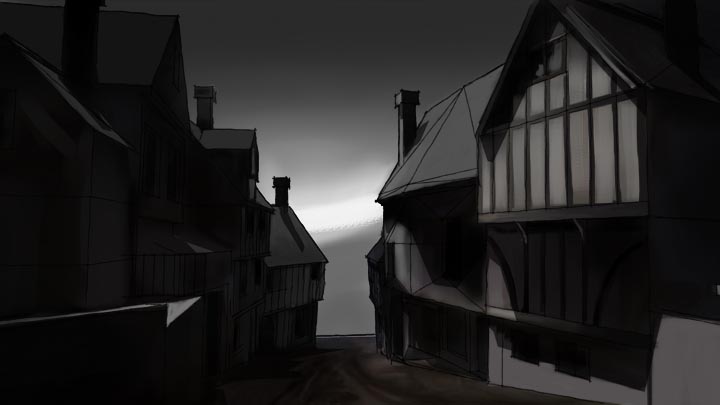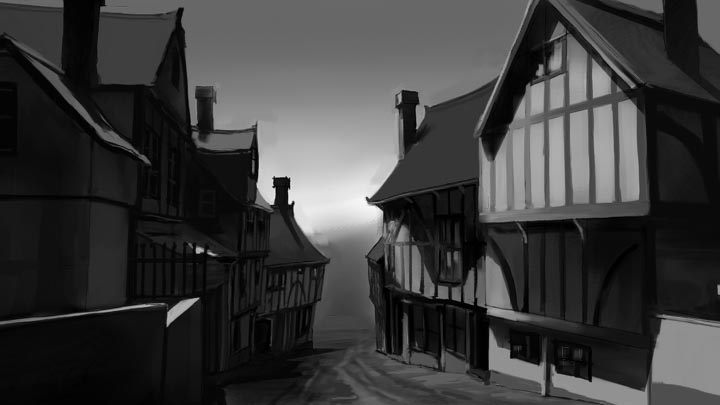Concept art + SketchUP - 'Lesbian Vampire Killers' film
-
Blimey - been a long time since I've posted anything here.

If you live in the UK, you can't have failed to notice that the... erm... 'interestingly' titled 'Lesbian Vampire Killers' film is out.
I did quite a bit of work on it as a concept artist and matte painter, and SketchUP saw quite a bit of use.
These paintings were used as backgrounds in the prologue - with a bit of defocus and lens bloom, they looked surprisingly real...
SketchUP:

Painting:

SketchUP:

Painting:

SketchUP:

Painting:

And another concept painting. Subject matter, if I've done my job right, should be obvious.

SketchUP:

Painting:

EDIT: Forgot about this one too - from the CGsociety 'Steampunk' challenge. Scylla attacks the Odyssey...
SketchUP:

Painting:

Enjoy! All SU images are native renders from SU6. I haven't found any pressing reason to upgrade to SU7 - dynamic components are a bit useless to me, and that seemed to be all that was new. Am I missing anything significant?
AJ
-
Amazing painting looks very jealous Got a good healthy dollop of atmosphere in there

as for Su7, the main thing that springs to mind is improved image export. You can go up to 9999xwhatever in 7

-
Biblicgothic!

-
These are excellent images - thanks for sharing!
-
Wow, very nice art work!

-
picks jaw up Wow!!
I wish I had your digital painting skills, excellent work mate.
-
Simply amazing. Is it ArtRage 2.5?
-
Inspiring Awe! Love your website too!
-
Wow, great to see such a cool combination of real-life and virtual painting !
-
excellent work
 , especially with photoshop, congratulations
, especially with photoshop, congratulations
need tips and pricks
-
Alex!! Was wondering where you'd been. Obviously busy by the looks of things

Lovely work, as always. Hopefully we'll be seeing you more regularly on here.cheers,
Andy.
-
nice.
really liking the first b&w shot. -
The first 3 pictures and render are heroic fantasy like. They could be front pages of books!

MALAISE -
Amazing! What post processing software do you use Alex?
-
Thanks for the comments everyone - I'll try to post a bit more often...

All the post processing / painting is done in Corel Painter X. Final colour correction / cropping in photoshop, but it's almost all painter.
Any natural media painting package would be fine for the job, since it's not really about any definite series of techniques beyond what any painting book would be able to tell you
 . I don't use Artrage, as I'm not used to it, but I've seen some amazing stuff from people who do.
. I don't use Artrage, as I'm not used to it, but I've seen some amazing stuff from people who do.Here is a rough guide to the process - I won't go too much into the painting, since this is an SU forum after all...
Step 1 - native SU output with the style 'sketchy pen black', face style 'hidden line', and shadows on. Saved as a .tiff with 'make background transparent' turned on (will be important later).

Step 2 - load the SU image in the art package of choice. It must support layers, because the first step is to copy the SketchUP image to layer 1, and set the blend mode to 'multiply'. You've then got a blank canvas, with the SU linework sitting on top of it in another layer. Because it's set to 'multiply', you can then happily start painting on the canvas, underneath the linework. I use a watercolour brush for this.

Step 3 - because the SU image had 'make background transparent' ticked when it was saved, it is possible to extract a matte of the buildings as an alpha channel. This is then used a layer mask on a new 'sky background' layer. You can then paint as rough as you want in the sky, knowing that the roofline will stay perfectly crisp and sharp.

Step 4 - make a new layer, and start painting in the detail. I use a square chalk brush for this, since it doesn't blend or pick up any of the colour underneath it. This isn't a worry in photoshop, where no brushes pick up previously applied colour. To recap:
Layer 0 (canvas): Rough watercolour painting
Layer 1: SketchUP render set to blend mode 'multiply'
Layer 2: Sky, with a layer mask extracted from the SketchUP render.
Layer 3: Painted detail
Step 5 - Finishing. For this I use a digital oil brush, which DOES pick up colour that is already sitting on the canvas. I can therefore use it to blend edges, soften gradients, and generally 'bed in' the painted detail. There's a bit of airbrushing for the atmospheric glow, and some fractal brushwork in photoshop for the chimney smoke.

This how I do almost all of my paintings. I've tried skipping the SketchUP part on a number of occasions (and starting with either a hand-drawn sketch, or just painting blindly), and the result is always substandard. It just great to be able to 'try out' all the possible angles, camera lenses, etc in SU, rather than endlessly thumbnailing - the composition always ends up miles better.
Hope that gives some folks here an idea or two...
AJ
-
excellent skills. and thanks for the step by step lead there alex. amazing.
-
great work, Alex.
thank you very much for the tutorial!
-
Thank you very much!
Sheer genius!
I'll try it in ArtRage... as soon as I get a tablet. -
Ecuadorian: Although I now use Painter, I spent a while working wth Artrage - you can certainly get equally good results with this great little package. Painter does make the whole process a little easier, but then you do pay for it!
Alex: just taken the time to look over your re-vamped (pun not intended) website. Nice to see the new stuff in there! What I particularly like about your work is that even the 'photo-real' matte work retains a subtle painterly quality. For reasons I can't quite pin-down, this style always seems to integrate a litte better with the original filmed footage than the ultra-slick cgi style that is so prevelant now. Perhaps because the paint strokes are reminiscent of film-grain...? (although know you also add grain digitally) I hope the increasing trend to film on-set with digital cameras won't mean a decline in this painterly style.
cheers,
Andy.
-
I have translated your tutorial in French for the French section


Advertisement







